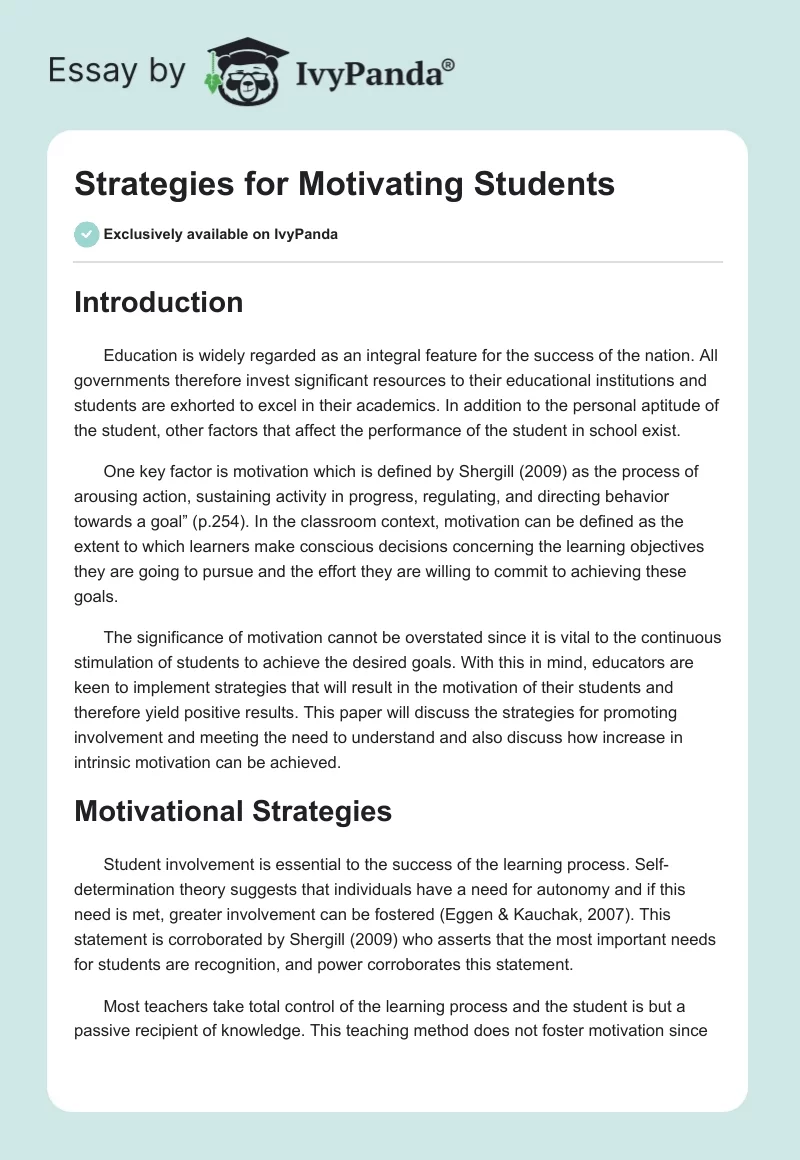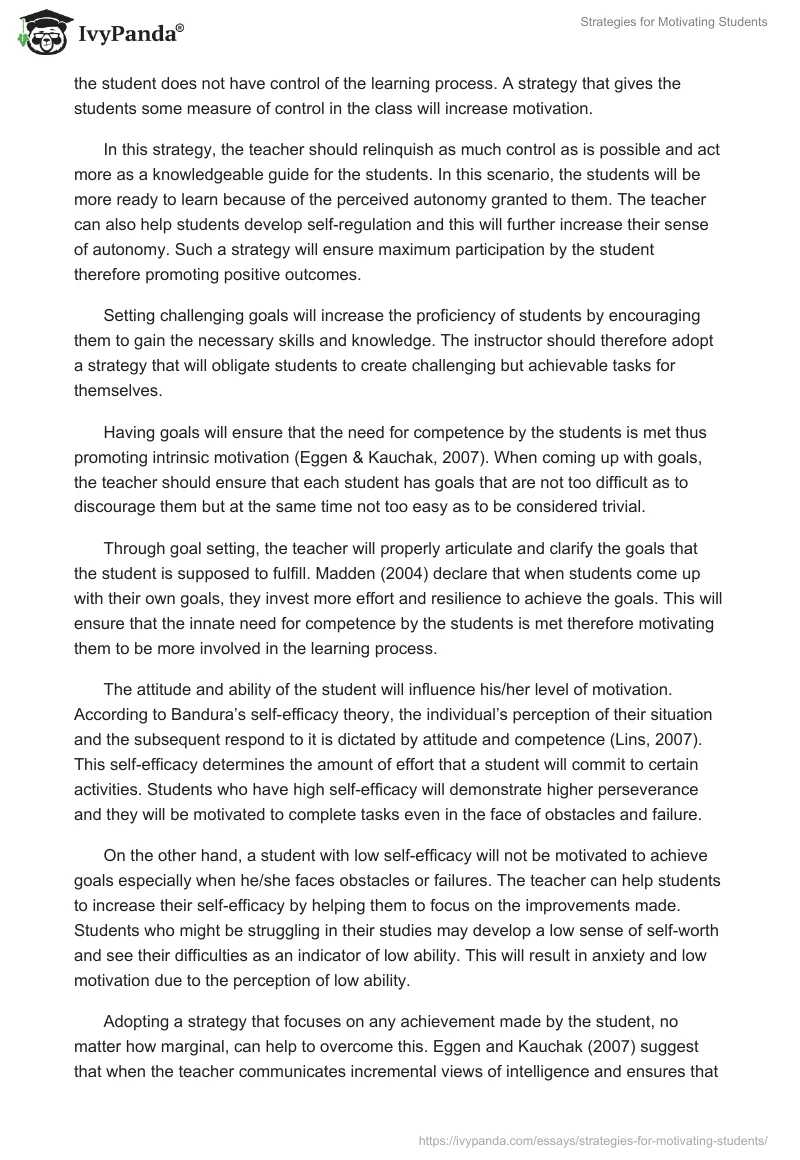Introduction
Education is widely regarded as an integral feature for the success of the nation. All governments therefore invest significant resources to their educational institutions and students are exhorted to excel in their academics. In addition to the personal aptitude of the student, other factors that affect the performance of the student in school exist.
One key factor is motivation which is defined by Shergill (2009) as the process of arousing action, sustaining activity in progress, regulating, and directing behavior towards a goal” (p.254). In the classroom context, motivation can be defined as the extent to which learners make conscious decisions concerning the learning objectives they are going to pursue and the effort they are willing to commit to achieving these goals.
The significance of motivation cannot be overstated since it is vital to the continuous stimulation of students to achieve the desired goals. With this in mind, educators are keen to implement strategies that will result in the motivation of their students and therefore yield positive results. This paper will discuss the strategies for promoting involvement and meeting the need to understand and also discuss how increase in intrinsic motivation can be achieved.
Motivational Strategies
Student involvement is essential to the success of the learning process. Self-determination theory suggests that individuals have a need for autonomy and if this need is met, greater involvement can be fostered (Eggen & Kauchak, 2007). This statement is corroborated by Shergill (2009) who asserts that the most important needs for students are recognition, and power corroborates this statement.
Most teachers take total control of the learning process and the student is but a passive recipient of knowledge. This teaching method does not foster motivation since the student does not have control of the learning process. A strategy that gives the students some measure of control in the class will increase motivation.
In this strategy, the teacher should relinquish as much control as is possible and act more as a knowledgeable guide for the students. In this scenario, the students will be more ready to learn because of the perceived autonomy granted to them. The teacher can also help students develop self-regulation and this will further increase their sense of autonomy. Such a strategy will ensure maximum participation by the student therefore promoting positive outcomes.
Setting challenging goals will increase the proficiency of students by encouraging them to gain the necessary skills and knowledge. The instructor should therefore adopt a strategy that will obligate students to create challenging but achievable tasks for themselves.
Having goals will ensure that the need for competence by the students is met thus promoting intrinsic motivation (Eggen & Kauchak, 2007). When coming up with goals, the teacher should ensure that each student has goals that are not too difficult as to discourage them but at the same time not too easy as to be considered trivial.
Through goal setting, the teacher will properly articulate and clarify the goals that the student is supposed to fulfill. Madden (2004) declare that when students come up with their own goals, they invest more effort and resilience to achieve the goals. This will ensure that the innate need for competence by the students is met therefore motivating them to be more involved in the learning process.
The attitude and ability of the student will influence his/her level of motivation. According to Bandura’s self-efficacy theory, the individual’s perception of their situation and the subsequent respond to it is dictated by attitude and competence (Lins, 2007). This self-efficacy determines the amount of effort that a student will commit to certain activities. Students who have high self-efficacy will demonstrate higher perseverance and they will be motivated to complete tasks even in the face of obstacles and failure.
On the other hand, a student with low self-efficacy will not be motivated to achieve goals especially when he/she faces obstacles or failures. The teacher can help students to increase their self-efficacy by helping them to focus on the improvements made. Students who might be struggling in their studies may develop a low sense of self-worth and see their difficulties as an indicator of low ability. This will result in anxiety and low motivation due to the perception of low ability.
Adopting a strategy that focuses on any achievement made by the student, no matter how marginal, can help to overcome this. Eggen and Kauchak (2007) suggest that when the teacher communicates incremental views of intelligence and ensures that the student focuses on their progress, negative self-perception by students who are struggling will be reduced.
Climate and Instructional Variables
The climate and instructional variables play a crucial role in the motivation of students. The teacher should cultivate certain personal qualities in order to increase motivation in students. The teacher can demonstrate a genuine commitment to the learning process and show concern for the progress made by the students.
Eggen and Kauchak (2007) state that by communicating genuine interest, the teacher is able to ignite motivation among the students who are inspired by the teacher’s dedication and feel the need to reciprocate by performing well. Teacher commitment will also demonstrate the importance of education and students will be inclined to show the same dedication to learning.
Interest in learning can be increased by having the teacher provide feedback to students. Performance feedback to the student will contribute to the increase in motivation by meeting the need to understand. Through feedback, the student will be made aware of desirable behavior and this will increase the chances of this behavior being repeated (Lins, 2007).
The teacher will also be in a position to commend the student for any progress made therefore encouraging growth. Feedback should always be provided in a timely fashion and the teacher should make sure that the student is able to easily link the feedback provided to desired class performance.
The classroom environment plays a major role in the learning process. Lins (2007) demonstrates that a friendly atmosphere where interaction among students is encouraged yields better results than an unfriendly environment. The teacher should endeavor to create this friendly environment and establish good rapport to promote a feeling of belonging by all class members.
Eggen and Kauchak (2007) contend that these feelings of relatedness inspire students to devote additional effort to attaining academic success. The rationale behind this is that in a friendly environment, the students will have realized the safety needs that appear in the lower level of Maslow’s hierarchy of needs. The students will therefore commit their efforts to attaining the higher needs of self-actualization and academic achievements will fall in this category.
Promoting Intrinsic Motivation
Of the two kinds of motivation, intrinsic motivation is regarded as the most beneficial to the student. Intrinsically motivated students will be committed to performing the desired activities and reaching set goals because of their own desire.
On the contrary, extrinsic motivation required an external motivator in the form of either a reward for reaching goals or the threat of punishment if the goal is not reached. Eggen and Kauchak (2007) contend that educators should cultivate intrinsic motivation, which will lead to the situation where students are involved in the education process because of an internal drive of curiosity or the need to overcome challenges.
Intrinsic motivation can be cultivated by adopting strategies that promote this form of motivation. By increasing self-efficacy in students, they are likely to engage in academic activities to satisfy their curiosity or overcome challenges. Teachers can also stop attaching rewards to student performance in class since such a strategy will only promote extrinsic motivation. Promoting intrinsic motivation will ensure that students remain motivated even when there is no tangible benefit for their actions.
Conclusion
Adopting motivational strategies is integral to achieving and sustaining positive outcomes in the classroom. This paper set out to discuss strategies that can be employed to inculcate motivation among students. It began by suggesting ways in which the teacher can promote student involvement in the classroom.
While human motivation is extremely complex, the paper has endeavored to show how it can be achieved in the classroom using certain strategies. The paper has discussed some of these strategies for promoting motivation and reinforced their applicability by referencing a number of prominent motivational theories. By utilizing these strategies, educators will succeed in motivating students and increase their likelihood of achieving academic success.
References
Eggen, P.D. & Kauchak, D.P. (2007). Educational psychology: windows on classrooms. Virginia: Prentice/Merrill/Prentice Hall.
Lins, T. (2007). Motivation and Second Language Learning. Boston: GRIN Verlag.
Madden, L. (2004). Motivating Students to Learn Better Through own Goal-Setting. Education, 117(3), 411-415.
Shergill, H.K. (2009). Psychology. NY: PHI Learning Pvt. Ltd.


